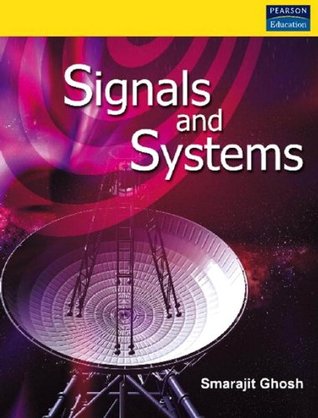

Most ebook files are in PDF format, so you can easily read them using various software such as Foxit Reader or directly on the Google Chrome browser.
Some ebook files are released by publishers in other formats such as .awz, .mobi, .epub, .fb2, etc. You may need to install specific software to read these formats on mobile/PC, such as Calibre.
Please read the tutorial at this link: https://ebookbell.com/faq
We offer FREE conversion to the popular formats you request; however, this may take some time. Therefore, right after payment, please email us, and we will try to provide the service as quickly as possible.
For some exceptional file formats or broken links (if any), please refrain from opening any disputes. Instead, email us first, and we will try to assist within a maximum of 6 hours.
EbookBell Team

0.0
0 reviews 
ISBN 10: 8177583808
ISBN 13: 9788177583809
Author: Smarajit Ghosh
This Book Provides Comprehensive Coverage Of All Topics Within The Signals And Systems Paper Offered To Undergraduates Of Electrical And Electronics Engineering.
1: Introduction to Signals
1.1: Signal Classifications and Properties
1.2: Signal Size and Norms
1.3: Signal Operations
1.4: Common Continuous Time Signals
1.5: Common Discrete Time Signals
1.6: Continuous Time Impulse Function
1.7: Discrete Time Impulse Function
1.8: Continuous Time Complex Exponential
1.9: Discrete Time Complex Exponential
2: Introduction to Systems
2.1: System Classifications and Properties
2.2: Linear Time Invariant Systems
3: Time Domain Analysis of Continuous Time Systems
3.1: Continuous Time Systems
3.2: Continuous Time Impulse Response
3.3: Continuous Time Convolution
3.4: Properties of Continuous Time Convolution
3.5: Eigenfunctions of Continuous Time LTI Systems
3.6: BIBO Stability of Continuous Time Systems
3.7: Linear Constant Coefficient Differential Equations
3.8: Solving Linear Constant Coefficient Differential Equations
4: Time Domain Analysis of Discrete Time Systems
4.1: Discrete Time Systems
4.2: Discrete Time Impulse Response
4.3: Discrete Time Convolution
4.4: Properties of Discrete Time Convolution
4.5: Eigenfunctions of Discrete Time LTI Systems
4.6: BIBO Stability of Discrete Time Systems
4.7: Linear Constant Coefficient Difference Equations
4.8: Solving Linear Constant Coefficient Difference Equations
5: Introduction to Fourier Analysis
5.1: Introduction to Fourier Analysis
6: Continuous Time Fourier Series (CTFS)
6.1: Continuous Time Periodic Signals
6.2: Continuous Time Fourier Series (CTFS)
6.3: Common Fourier Series
6.4: Properties of the CTFS
6.5: Continuous Time Circular Convolution and the CTFS
6.6: Convergence of Fourier Series
6.7: Gibbs Phenomena
7: Discrete Time Fourier Series (DTFS)
7.1: Discrete Time Periodic Signals
7.2: Discrete Time Fourier Series (DTFS)
7.3: Common Discrete Fourier Series
7.4: Properties of the DTFS
7.5: Discrete Time Circular Convolution and the DTFS
8: Continuous Time Fourier Transform (CTFT)
8.1: Continuous Time Aperiodic Signals
8.2: Continuous Time Fourier Transform (CTFT)
8.3: Common Fourier Transforms
8.4: Properties of the CTFT
8.5: Continuous Time Convolution and the CTFT
9: Discrete Time Fourier Transform (DTFT)
9.1: Discrete Time Aperiodic Signals
9.2: Discrete Time Fourier Transform (DTFT)
9.3: Common Discrete Time Fourier Transforms
9.4: Properties of the DTFT
9.5: Discrete Time Convolution and the DTFT
10: Sampling and Reconstruction
10.1: Signal Sampling
10.2: Sampling Theorem
10.3: Signal Reconstruction
10.4: Perfect Reconstruction
10.5: Aliasing Phenomena
10.6: Anti-Aliasing Filters
10.7: Discrete Time Processing of Continuous Time Signals
11: Laplace Transform and Continuous Time System Design
11.1: Laplace Transform
11.2: Common Laplace Transforms
11.3: Properties of the Laplace Transform
11.4: Inverse Laplace Transform
11.5: Poles and Zeros in the S-Plane
11.6: Region of Convergence for the Laplace Transform
11.7: Rational Functions and the Laplace Transform
11.8: Differential Equations
11.9: Continuous Time Filter Design
12: Z-Transform and Discrete Time System Design
12.1: Z-Transform
12.2: Common Z-Transforms
12.3: Properties of the Z-Transform
12.4: Inverse Z-Transform
12.5: Poles and Zeros in the Z-Plane
12.6: Region of Convergence for the Z-Transform
12.7: Rational Functions and the Z-Transform
12.8: Difference Equations
12.9: Discrete Time Filter Design
13: Capstone Signal Processing Topics
13.1: DFT- Fast Fourier Transform
13.2: The Fast Fourier Transform (FFT)
13.3: Deriving the Fast Fourier Transform
13.4: Matched Filter Detector
14: Appendix A - Linear Algebra Overview
14.1: Basic Linear Algebra
14.2: Eigenvectors and Eigenvalues
14.3: Matrix Diagonalization
14.4: Eigen-Stuff in a Nutshell
14.5: Eigenfunctions of LTI Systems
15: Appendix B - Hilbert Spaces Overview
15.1: Fields and Complex Numbers
15.2: Vector Spaces
15.3: Norms
15.4: Inner Products
15.5: Hilbert Spaces
15.6: Cauchy-Schwarz Inequality
15.7: Common Hilbert Spaces
15.8: Types of Bases
15.9: Orthonormal Basis Expansions
15.10: Function Space
15.11: Haar Wavelet Basis
15.12: Orthonormal Bases in Real and Complex Spaces
15.13: Plancharel and Parseval's Theorems
15.14: Approximation and Projections in Hilbert Space
16: Appendix C - Analysis Topics Overview
16.1: Introduction to Metric Spaces
16.2: Convergence of Sequences
16.3: Convergence of Sequences of Vectors
16.4: Uniform Convergence of Function Sequences
sampling theorem in signals and systems
signal definition in signals and systems
bp lathi signals and systems
mit signals and systems
classification of signals and systems
ec3354 signals and systems notes
Tags: Smarajit Ghosh, Signals, Systems